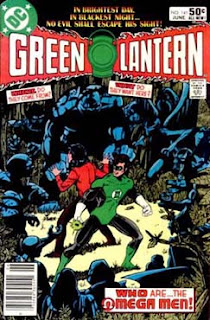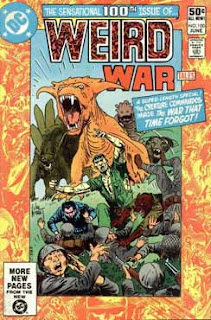The Aquaman backup by DeMatteis/Heck comes to an end (that's even the title). Aquaman and the robot Poseidon with his dad's mind go to confront his crazy mom. She throws a bunch of robots at him in the form of his foes, highlighting how obscure most of Aquaman's rogue's gallery are. In the end, her sister shows up and reveals Aquaman isn't the prophesized one. Atlanna sees the error of her ways and says she's sorry, then destroys herself and the robots. Aquaman opines that as far as he's concerned, this parents were gone a long time ago, practically stating outright that this storyline will be ignored in the future.
Wednesday, March 16, 2022
Wednesday Comics: DC, June 1981 (wk 2 pt 1)
The Aquaman backup by DeMatteis/Heck comes to an end (that's even the title). Aquaman and the robot Poseidon with his dad's mind go to confront his crazy mom. She throws a bunch of robots at him in the form of his foes, highlighting how obscure most of Aquaman's rogue's gallery are. In the end, her sister shows up and reveals Aquaman isn't the prophesized one. Atlanna sees the error of her ways and says she's sorry, then destroys herself and the robots. Aquaman opines that as far as he's concerned, this parents were gone a long time ago, practically stating outright that this storyline will be ignored in the future.
Monday, March 14, 2022
Marvel Super-Heroes with Step Dice
I got a set of those unusual DCC polyhedrals this weekend just for the hell of it, and I was musing on Discord how you could replicate the MSHRPG rankings (Feeble to Unearthly) with a complete set of those dice, like this: Fe (d4), Pr (d5), Ty (d6), Gd (d7), Ex (d8), Rm (d10), In (d12), Am (d14), Mn (d16), Un (d20).
I suppose switching to that sort of mechanic would allow you to ditch the action table, but but keeping something even loosely approximate to the success percentages of the actual game would probably be complicated enough to require one, as shown here:
If you didn't care about sticking as closely as possible to Marvel's percentages (and admittedly, even with this, you've had to give up on the chance of a red success for lower scores) then you could give flat roll thresholds: 4 for green, 7 for yellow, and 10 for red.
I don't actually think there is any reason to do this, but it was amusing to think about.
Thursday, March 10, 2022
Pulp Sci-Fi Technology
Star Wars (and to a lesser extent Star Trek) are products of their respective eras in regard to the futuristic technology then portray (or don't feature), but both are also probably beholden to their pulp antecedents and the imagine (and failures of imagination) of the authors that wrote them.
- Radium: Radium seems almost sort of unobtanium in a lot of old stories, an is imbued with uses and properties it doesn't really possess in real life. This goes along with...
- Radiation: Various sorts of radiation (or even sometimes a vaguer property called "vibration" of matter or energy) can do almost magical things. This continues in science fiction, of course, but by the Atomic Age the language used to describe it much less mystical.
- Mechanical not Electronic: One can hardly fault writers of the 20s-40s for not including many (or often any) computers in their works, beyond the occasional mechanical brain, but it's interesting how even the electrical devices appear sparingly, outside of things like visiplates/visiphones (visual communication devices). Some more planetary romance leaning authors like Leigh Brackett, tend to describe virtually none of this sort of technology. This has implications we might not think of: Edmond Hamilton's stories for instance have no jail cells with coded keypads or even simply push button keypads like Star Trek. All his futuristic locks seem to require a hand held "vibratory key."
- Planet and ship based: Artificial satellites and space stations are very rare. In fact, I don't think I've read a story written before the 50s that had them.
- Acquired not Synthesized: Many more breakthrough materials or pharmaceuticals are harvested from alien worlds that made in the laboratory. Even breakthrough laboratory discovers often require some exotic "natural" material.
- Solitary Inventor: Great scientific leaps from space travel to super-weapons are typically the province of single geniuses or experimenters, not teams of government or industry-funded scientists. First space travel is almost always mentioned as a work of a sort of Wright Brothers instead of a NASA.
- Atomic Energy: Everything is atomic powered it seems like.
- No TV: I'm sure there are stories that make reference to something like television as an entertainment medium, but it appears in very few stories.
Wednesday, March 9, 2022
Wednesday Comics: DC, June 1981 (wk 1 pt 2)
Monday, March 7, 2022
A Game I Would Like to Have Seen
Logan's Run may have come out a bit too early for an rpg tie-in, but it seems like the sort of thing FASA would have got a hold of if anybody did.
I think the setting has a lot of rpg potential, particularly as developed in the TV series.
Sunday, March 6, 2022
Weird Revisited: The Life Aquatic
 |
| A merman and his landwoman bride. Grand Lludd, 5825. |
In the waters west of Ibernia, ship passengers occasionally glimpse and wonder at light in the depths. These are the lights Undersea, municipality of the mer-folk. Part of the empire of Grand Lludd, the citizens of Undersea have never been Her Preserved Majesty’s most loyal servants. Only the threat of submarine bombardment has stifled open rebellion at times. Still, in these hard years following the Great War, land and sea need each other too much for such squabbles.
The mer-folk are not to be confused with mermaids, despite similarity in names. Those half-fish creatures (and wholly nonhuman, whatever their appearance) are more akin to faerie. Mer-folk look, for the most part, like surface humans except for a slight bluish tint to their skin, eyes a little larger than usual, webbed hands, and a slight tendency to barrel-chestedness--though its common for portrayals of them in art to exaggerate their inhumanness. So little apparent difference for beings naturally inhabiting great depths and pressures hint at the subtle magics that have been used to adapt them to a submarine life. Scientists suggest this points to them being an engineered race, perhaps derived from Meropian stock. Mer-folk find this whole line of speculation dull, and are largely unconcerned with their own origins.
Perhaps its this lack of curiosity, among other traits, that has led to the common Lluddish stereotype of Mer-folk as thickwitted. They're also held to quick-tempered and lascivious (a judgement perhaps derived from their indifferent attitude toward clothing--at least in the seas). Mer-folk don’t drink (at least not in their usual habitat) but their men tend to enjoy licking certain sea slugs for an intoxicant effect, and singing (it can be called that) gurgling, warbling shanties, while their women perform suggestive, water ballet-like dances.
Though they are limited in the areas of metallurgy, chemcal, and alchemical sciences, the mer-folk are not utter primitives. They use magic to shape stone for buildings, and have either used animal husbandry or magic to enhance the abilities of sea creatures for their use. The lantern jellyfish sometimes seen in aquariums are best known example.
On land, mer-folk must wear something like reverse diving suits--pressurized suits filled with water--unless they have access to magic aid. They're able to breath air, but the exertion quickly tires them and it's uncomfortable for more than a half-hour or so. Their skin quickly dries out in air, as well. The use of heavy suits isn't as cumbersome as it might seem as mer-folk are stronger than a surface human of comparable size.
There are some mer-folk enclaves in the New World. The largest of these are in New Lludd, there mer-folk are involved in fishing, and the Southron coast where they engage in sponge harvesting, as well.
Friday, March 4, 2022
Constraints & Creativity
People are free to like what they like, of course, but I don't agree with these complaints for the most part. Every setting or game excludes as many things (or more) as it includes in how it defines itself. Even kitchen sink or gonzo settings have parameters and boundaries. Game systems themselves constrain with their rules.
There is obviously some give and take here. A GM who wants to run a D&D setting with more than the usual restrictions on options should communicate that and probably the reasons for it before hand, but armed with that knowledge, players ought to trying to make up characters that would fit the setting and negotiating with the GM regarding parameters. Honestly, I feel like I've had just as much fun playing a well-defined pregen than making up my own character, at least for short-run games.
I'm hardly the first to note this, but it seems to me constraint can stimulate creativity. It's true on the player side, but I think it's also true on the GM/setting creation side. With an large number of worlds to play with, it should be a trivial matter coming up with interesting planets, but the Star Wars franchise seems to have a tough time showing us anything but the same three or four biomes over and over. And most of those are are one biome: deserts, but perhaps that's a different problem. I don't think Star Wars is the only franchise that lets quantity substitute for quality. It's easy to do.
But If you've got a smaller number of worlds like a solar system, you've got to make every one count, and you might well use each one to it's fullest. Maybe they aren't all single biome planets, but even if they are, you would tend to have them have different sorts of jungle or different sorts of deserts to get the most out of it. All of that is creativity you would never have been forced to exercise if you had a bunch of planets to spare.
Maybe its just me. Try it for yourself, by self-imposing some constraints you wouldn't normal give yourself in worldbuilding or adventure design and see how it turns out.

























